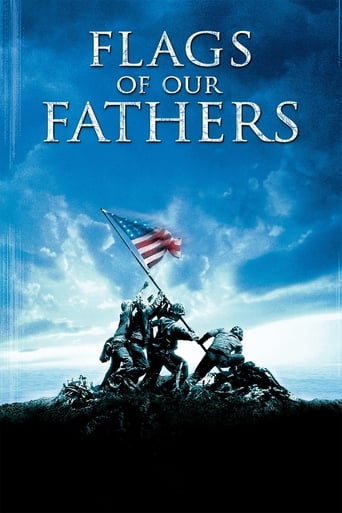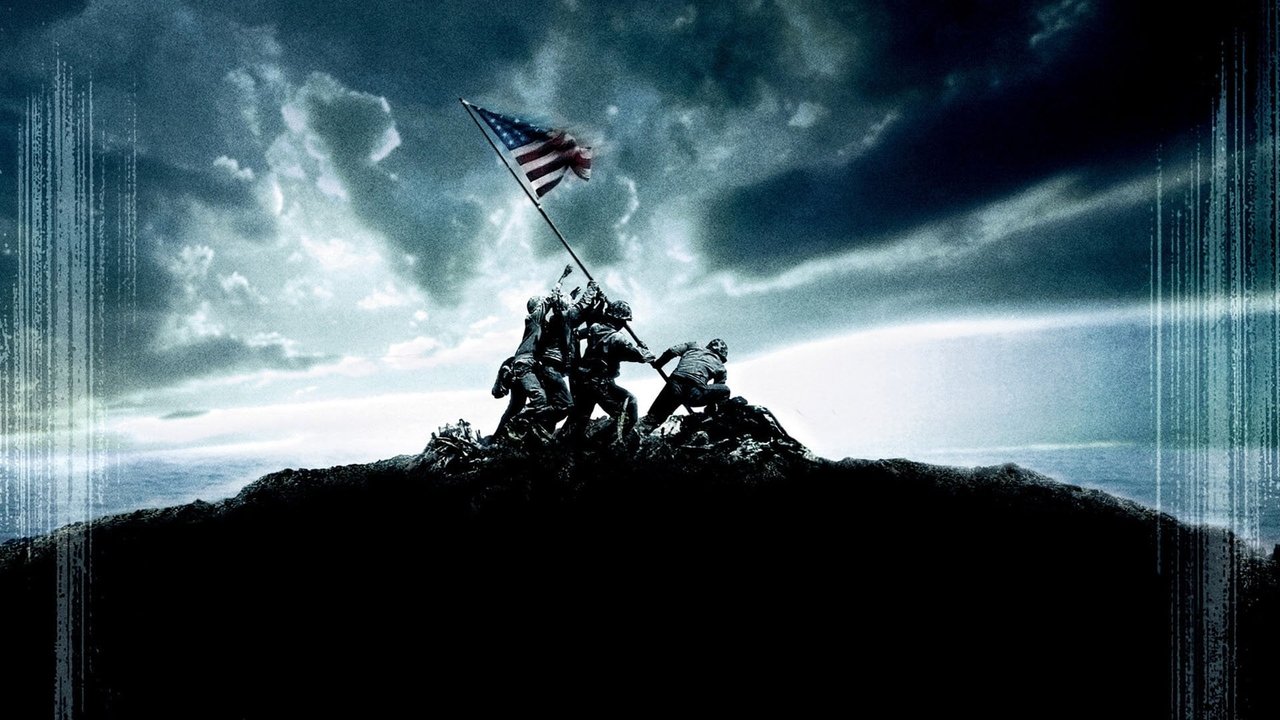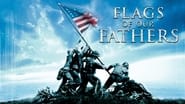Dr Jacques COULARDEAU
This film concerns the last real fierce emblematic battle (February 19, 1945 - March 26, 1945) between the USA and Japan, the battle for the island of Iwo Jima. The war is coming to an end and after this battle, it will drag on with Japan retreating little by little and this will only be stopped once and for all with the atom bombs of Hiroshima and Nagasaki. At the end of this battle, the federal government of the USA is unable to finance the end of the war and they use this battle, this victory as the tool they need to launch a final battle in the USA to raise the money necessary to finish the job. But when this battle is finished, won the main actor of this war, Franklin D. Roosevelt dies within weeks on April 12, 1945, and Truman takes over. He is the one who decided to drop the atom bombs in Japan, though of course, Roosevelt is the one who had launched the research and financed the production of these bombs, little boy as the first one was called. Dramatic event that required the levying of millions if not billions of dollars to pay for the next six months of the war. This first film - that has to be twinned with Letters from Iwo Jima - is the battle seen from the American point of view and what's more from the recollections the son of one of the GIs who raised the flag there managed to collect from his father before his death, and the father expressed in his last weeks or months of life the great distance he had taken with this war and this battle. The film shows with all the horror and bloody cruelty you can imagine this battle and how the GIs reacted and survived because that's the master word here: The Gis did all they could to survive and avoid the bullets. Their choice was simple: go through the showering bullets, remain alive, and kill as many people on the other side. Prisoners were not even a question. Then the film shows how three surviving soldiers who raised the flag are enrolled in a campaign across the USA to raise money, including by the reenactment of the raising of the flag. But it is all built on a fake picture. The first raising of the flag was not taken by the photographer following the armed forces, a GI himself, because he was not thre at the time. He only took the "second raising" but in the meantime, one of the four Gis who did it was dead or gone and he was replaced by a second fourth one who will die soon after. The picture that was sent around in the press and the media all over the world cheated then on the identity of this fourth soldier. And both fourth soldiers dying soon after and not being there anymore to testify, two mothers, two families were suffering from the ambiguity. The truth came from one of the three survivors, the Indian GI, who later on, after the war, leaked the truth to the press. The fact that remains is that the federal state and the American political apparatus used this picture and this event for years with even the erecting of a monument representing this particular event. What is important in such situation? The real truth or the dynamism that the official but false truth creates? The reality is that very often the hypocritical truth is the one that works in the media, most of the time because the media do not know it is fake. And today some speak of fake news!The three survivors will have very different careers after the war. The Indian will die officially from exposure sometime after the inauguration of the official commemorative monument, without an autopsy, meaning that an Indian is an Indian and his being a national hero does not count: he is still refused a drink in a bar that does not serve Indians, even when the whole city around the bar is celebrating on this very evening the three survivors and the raising of the flag in a monstrous event in some stadium. The next GI will never get a decent job, nor decent training or education, and he will be a janitor all his life. The last one will have the opportunity to buy a funeral parlor and will prosper as a mortician and he is the one whose son is collecting the last memories.The general idea is that if heroes there are they are all dead: the heroes are those who died in the battle. The survivors were just die-hard lucky survivors who managed to run through a torrentuous shower of projectiles of all sorts and did not get wet at all. Dry till the end, or maybe one or two drops, one or two wounds, but nothing serious enough to put you six feet under. In 2006 the wars in Afghanistan and Iraq were getting clogged up in a quagmire and Clint Eastwood and Steven Spielberg had the courage to tell the wide audience that a war is never anything clean, heroic and that it is essentially a cruel game played by people far away from the front who will use the survivors to reach their objectives provided these survivors do NOT, absolutely NOT, question the basic principles of the society whose elite the war-players at home are, namely segregation and class distinctions, not to mention racism and racial distinctions. Dr. Jacques COULARDEAU
adamcarter-63372
Flags of Our Fathers is a bit a of a hit and miss. On one hand the movie is quite different from other war films because most of the film's run-time takes place after the characters have "fought." The main focus in this film isn't about the war scenes and in fact they are more of a backdrop to the main plot. Usually it is the other way around in war films. It also has a very powerful message about how soldiers feel about being called heroes and how in reality that is just something we make up. Many scenes will stick with me including the ending shot of this film, a tense battle scene, and the scene when finally find out how one of the primary characters feel.On the other hand, the movie just doesn't do quite enough with this idea. It constantly and repeatedly beats us on the head trying to drive in an idea that the audience already understands. Also outside of the main conflict, the characters are so thin and underdeveloped that it is hard to connect with them. This movie needed great characters since this movie is centered around their emotions rather than battle scenes and a technical war plot. To care about this film, we need to feel through them. This movie has a counterpart (Letters from Iwo Jima) which shows the other side of the battle and that movie is a masterpiece which only makes this movie feel overshadowed. Flags of Our Fathers has a very important message, and is well worth watching, but it could've been handled so much better.
denis888
I like WWII movies a lot, and yeah, Clint Eastwood is a real genius, but Homer sometimes nods, so does Clint. What he created here is a mish mash of wild wanton battle scenes, long, much too long sad flashbacks, inept editing, sick sepia tone and on top of that, dry as dust, didactic Told-You_so way of hammering these things onto our heads. The actors are awesome, and they do their best. I cannot say anything poor about Pepper, Patrick, Walker or McDonough, as well as younger cast who also tried to do their best. But all their valiant attempts were buried by sentimental syrupy attitude, prolonged scenes, unnecessary brutal shots, too much of a method hammering, too much of a moral telling, and an overall preachy message that war is evil. We know this. It is indeed evil. The slow tempo of the movie kills all our sincere desire tom like it. We failed. The film is way too boring and tiring and ...yes...obvious. The effort is worth 4, not more
jjserpe
Recently, war movies have aroused great interest. Accordingly, a plethora of this sort of movies has invaded our cinemas. Maybe the two most popular war movies in recent years have been Saving Private Ryan, directed by Steven Spielberg, focused on the Normandy Landings, and Flags of our Fathers, directed by Clint Eastwood, focused on the battle of Iwo Jima (together with Letters from Iwo Jima, the Japanese view of the conflict, whose premiere in Spain will be held in few weeks). Both films show bloody scenes of fights and, as a result, the cruelty of the war. In addition, a large part of both films is focused on the miseries and attitudes towards death, danger and desperation of a small group of soldiers. Also common to both films is the fact that the main characters are actually antiheroes. The Spielberg's film takes place mostly in the battlefield and is perfectly linear. On the other hand, flashbacks are used in Flags of our Fathers in order to show both the war and the propaganda campaign undertaken by the main characters going across the United States. By virtue of this we can see a different drama in this film related to the feelings and problems of the soldiers when they come back home to undertake a mission they have not been trained for. Furthermore, we clearly identify with the leading actor in Saving Private Ryan (Tom Hanks). On the contrary, the three actors in Eastwood's film actually share the prominence. The strength of Saving Private Ryan lies in the intense representation of the war and it is a typical war film, maybe better than others, but a war film nevertheless. However, Flags of our Fathers is more complex. With his usual skill, Eastwood shows a combination of war and politics, death and propaganda.



 AD
AD






